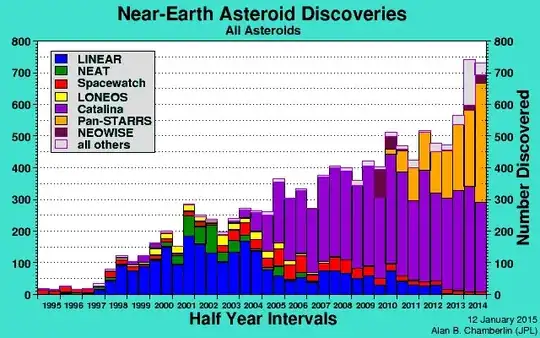
The article in question has the correct answer:
Any NEO that is going to hit the Earth will swing near our planet many times before it hits, and it should be discovered by comprehensive sky searches like Spaceguard.
There are many all-sky survey projects that would likely detect any civilization-damaging asteroid. And if the survey projects detect such an asteroid, it is almost certainly the case that they would discover it many years prior to impact. More all-sky surveys with better and better detection techniques will be coming online in the next decade and increase our chances of spotting a potential impactor. As surveys increase, we can anticipate a rise in reports of "near misses" and "potential impact" stories, even though what will really happen is that our chance of being caught unawares is reduced.
So to put some numbers and references to the previous paragraph:
The Torino Scale describes asteroid impact hazards. To achieve "serious damage to our civilization," as specified in the question, would require a Torino Scale 9 or 10 impact. Such impacts occur on average every 10,000-100,000 years.
We already have all-sky surveys that are specifically trying to trace "Near Earth Objects" and potential impactors. These are finding NEOs at an increasing rate (and this is likely to continue), but most large NEOs have probably been found, as shown in this image:


(source: nasa.gov)
We're discovering fewer and fewer large NEOs even as we're discovering more and more total NEOs. This indicates that the chances of us having missed a "sneak" Torino Scale 9 or 10 asteroid are increasingly slim.
In combination with being an undiscovered large NEO, the doomsday asteroid would additionally need to be in an orbit that hits us quickly. That's highly unlikely: of the almost 10,000 NEOs detected to date, none has ever impacted. None is even anywhere near likely to impact.
The probability of a doomsday asteroid sneaking up on us is the product of small probabilities: the odds of us having missed a large NEO * the odds of it having a bulls-eye course.
In summary, although there are many, many asteroids out there, the vast majority of which are undiscovered, we benefit from an important fact:
Space is big. You just won't believe how vastly, hugely, mind-bogglingly big it is. I mean, you may think it's a long way down the road to the chemist's, but that's just peanuts to space.
-- Douglas Adams


